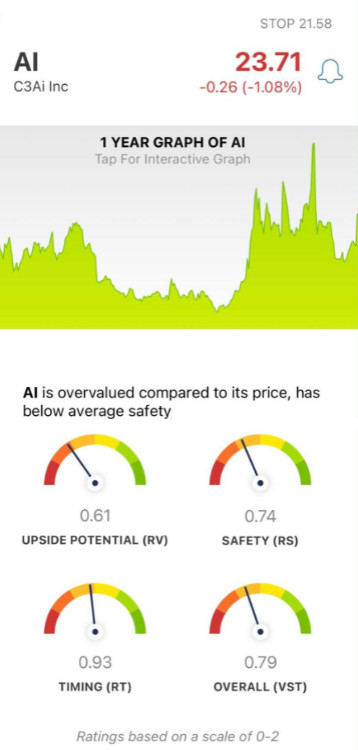When evaluating an AI stock trading predictor, the selection and complexity of algorithms are crucial elements that affect the model’s performance, interpretability, and adaptability. Here are ten tips to help you evaluate the complexity and selection of algorithms.
1. Algorithms for Time Series Data How do you determine their Validity
Why: Stocks are inherently time-series by nature and therefore require software capable of handling sequential dependencies.
How to: Verify the algorithm you select is suitable for time series analysis (e.g. LSTM or ARIMA) and/or can be adapted (like certain types of transformers). Avoid algorithms which may be unable to handle temporal dependence in the absence of time-aware functions.
2. Examine the algorithm’s ability to handle volatility in the Market
The reason: Because of the high volatility of the market, some algorithms are better able to handle the fluctuations.
How do you assess the algorithm’s capacity to adapt (like regularization, which is a feature of neural networks) or if it is purely based on smoothing technologies to avoid reacting each minor fluctuation.
3. Examine the model’s capacity to incorporate both fundamental and technical analysis
Why? Combining technical and fundamental data can increase the accuracy of stock predictions.
How do you confirm that the algorithm is able to handle various types of data inputs, and has been structured to interpret the quantitative (technical indicators) and qualitative (fundamentals) data. This can be accomplished best using algorithms that are able to manage mixed types of data including ensemble techniques.
4. Assess the level of complexity in relation to interpretationability
What’s the problem? Although complicated models, such as deep neural networks are extremely powerful and can often be more interpretable but they’re not always easy to understand.
How do you determine the appropriate balance between complexity and interpretability depending on your goals. Simplicer models (like decisions tree or regression models) could be more in situations in which transparency is essential. Complex models that are highly predictive may be justified, however they must be combined with their ability to be understood.
5. Check the scalability of the algorithm and computation requirements
The reason: Highly complex algorithms require a lot of computing power, which can be costly and inefficient in real-time environments.
How to ensure that the computation requirements of your algorithm are compatible with your existing resources. Scalable algorithms are generally preferred for high-frequency or large-scale data, while models with a heavy use of resources might be restricted to lower frequency strategies.
6. Check for Ensemble or Hybrid Model Usage
What is the reason: Ensemble models (e.g., Random Forest or Gradient Boosting) or hybrids can combine strengths from different algorithms, which can lead to higher performance.
How: Determine whether a forecaster is using an ensemble or hybrid approach to improve accuracy and stabilty. An ensemble of multiple algorithms can be used to ensure predictive accuracy while also ensuring robustness against weaknesses such as overfitting.
7. Analyze the Hyperparameter Sensitivity of Algorithm’s Hyperpara
Why: Some algorithms can be highly sensitive to hyperparameters. They impact model stability and performances.
How to determine if the algorithm requires extensive tuning and whether the model offers guidance on optimal hyperparameters. The algorithms that are resistant to minor changes in hyperparameters tend to be more stable.
8. Consider Market Shifts
What’s the reason: The market’s rules can suddenly change which causes the price driver to change.
How to find algorithms that can be adapted to the changing patterns of data. They include adaptive algorithms, or those that employ online learning. Modelling techniques, such as neural networks that are dynamic or reinforcement learning, are created to adapt and change with changing circumstances. They are ideal for markets that are constantly changing.
9. Make sure you check for overfitting
Why? Models that are too complex could be effective on historical data but struggle with generalization to new data.
How: Examine whether the algorithm incorporates methods to avoid overfitting like regularization, dropout (for neural networks) or cross-validation. Models that are focused on the simplicity of the selection of elements are less likely to be overfitted.
10. Algorithm Performance Considered in Different Market Situations
Why do different algorithms perform better under specific conditions (e.g. neural networks designed for markets that are trending and mean-reversion models to deal with range-bound markets).
How: Review performance metrics across various market conditions, such as bull, bear, and sideways markets. Make sure the algorithm is reliable, or can be adapted to various conditions. Market dynamics vary frequently.
Follow these tips to get a full knowledge of the algorithms’ selection and complexity within an AI stock trade predictor. This will allow you to make better informed choices about their suitability for specific trading strategies and the risk tolerance. Have a look at the top what do you think for stock prediction website for website info including ai stock picker, investing in a stock, market stock investment, ai stock price, ai stocks, best stocks for ai, ai stocks, ai stock analysis, buy stocks, ai copyright prediction and more.

How Do You Evaluate An Investment App By Using An Ai Trader Predictor For Stocks
To ensure that an AI-based trading application for stocks meets your investment goals You should take into consideration a variety of aspects. Here are 10 essential guidelines to consider when evaluating an app.
1. Examine the accuracy of the AI Model and Performance
The reason: The precision of the AI stock trade predictor is crucial to its efficacy.
How to check historical performance indicators such as accuracy rates as well as precision and recall. Review the results of backtesting and check how your AI model performed in different market conditions.
2. Review the Data Sources and Quality
Why? The AI model is only as accurate and precise as the information it is based on.
How to: Check the sources of data used by the app. This includes real-time data on the market along with historical data as well as news feeds. Ensure that the app is using trustworthy and reliable data sources.
3. Review the experience of users and the design of interfaces
What’s the reason? A user-friendly interface, especially for those who are new to investing is essential for efficient navigation and user-friendliness.
How to assess the overall design design, user experience and overall functionality. Look for features such as simple navigation, user-friendly interfaces and compatibility across all platforms.
4. Make sure that algorithms are transparent and in Predictions
What’s the reason? Understanding how an AI creates predictions will help to build trust in its recommendations.
Documentation that explains the algorithm used, and the factors used in making predictions. Transparent models can often increase the confidence of users.
5. Find Customization and Personalization Options
Why? Different investors have different investment strategies and risk appetites.
What to do: Find out if the app offers customizable settings that are based on your investment goals and preferences. The AI predictions are more useful if they’re customized.
6. Review Risk Management Features
What is the reason? A good risk management is essential to safeguarding capital investment.
How do you ensure that the app offers risk management strategies such as stop losses, portfolio diversification and position sizing. Assess how well the AI-based prediction integrates these features.
7. Analyze the Community Features and Support
Why: Access to information from the community and support from a customer can improve the investing experience.
How to: Look for options such as forums, discussion groups, or social trading platforms where customers are able to share their insights. Check the customer service availability and responsiveness.
8. Verify that you are Regulatory and Security Compliant. Features
The reason: Complying with the regulations ensures the app is legal and protects its users’ rights.
How to check whether the app has been tested and is in compliance with all applicable financial regulations.
9. Consider Educational Resources and Tools
Why: Educational resources can increase your knowledge of investing and assist you make informed decisions.
What to do: Find out if the app comes with educational material or tutorials that explain the investing and AI-based prediction concepts.
10. Reviews and Testimonials from Users
Why: Customer feedback is a great way to gain an understanding of the app it’s performance, as well as its reliability.
How: Explore user reviews on app stores as well as financial sites to evaluate user experiences. See patterns in the feedback regarding an app’s performance, features as well as customer support.
Check these points to assess the app for investing that utilizes an AI stock prediction predictor. This will make sure that it meets your investment requirements and helps you to make educated decisions about the stock market. View the recommended artificial intelligence stocks for more tips including ai stocks to buy, ai stock price, ai stock investing, ai trading, ai trading software, market stock investment, ai share price, incite, market stock investment, ai stock and more.
